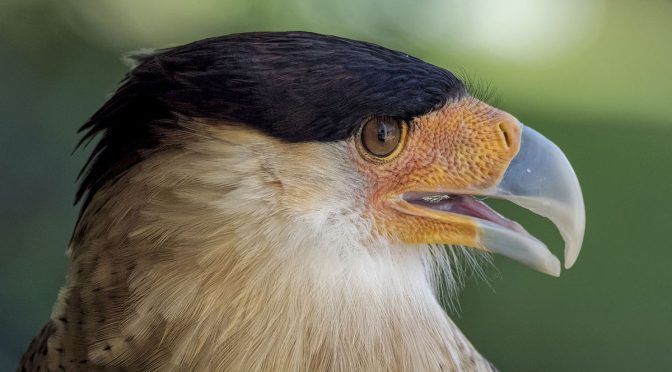During a recent one week vacation in Cuba I was able to capture a few images of a captive Crested Caracara. The bird’s owner was very congenial and interacted with many of the tourists. His Crested Caracara was quite tame and would gently perch on people’s forearms.
NOTE: Click on images to enlarge.

The Crested Caracara is a member of the falcon family and is seen in southern parts of Texas, Arizona, California and in areas of Florida. Its range extends through Mexico, Central America and into northern areas of South America. The northern species is also found in Cuba. There is another species of Crested Caracara that is found in South America.

On occasion Crested Caracaras have been known to stray northward with individual birds spotted as far north as Michigan. One bird was even spotted as far away as New Brunswick, Canada.

This medium sized raptor is a carnivorous scavenger that mainly feeds on carrion. Prey includes small mammals, amphibians, reptiles, turtles, crabs, eggs and nesting birds. The Crested Caracara is easily recognizable by its distinctive plumage. They are often seen in the presence of other carrion eating birds.

The Crested Caracara is most commonly seen south of the Mexico/United States border. In some areas it is locally referred to as the ‘Mexican Buzzard’.

The captive bird illustrated in this article was positioned adjacent to some steps leading into the main buffet restaurant, drawing a lot of interest from the diners. I only had a few narrow shooting angles that allowed me to compose my images without distracting backgrounds in them.
Technical Note:
All photographs in this article were captured hand-held using camera gear as per the EXIF data. All images were produced from RAW files using my standard process of DxO PhotoLab, CS6 and the Nik Collection.
Word of mouth is the best form of advertising. If you like our website please let your friends and associates know about our work. Linking to this site or to specific articles is allowed with proper acknowledgement. Reproducing articles, or any of the images contained in them, on another website or in any social media posting is a Copyright infringement.
My intent is to keep this photography blog advertising free. If you enjoyed this article and/or my website and would like to support my work, you can purchase an eBook, or make a modest $10 donation through PayPal. Both are most appreciated. You can use the Donate button below. Larger donations can be made to tom@tomstirr.com through PayPal.
Article and images are Copyright 2019 Thomas Stirr. All rights reserved. No use, duplication or adaptation of any kind is allowed without written consent. If you see this article reproduced anywhere else it is an unauthorized and illegal use. Posting comments on offending websites and calling out individuals who steal intellectual property is always appreciated!


Captured Wild Birds are just plain wrong!
Hi Dick,
I appreciate your point of view. I’m unclear on the exact status of the bird i.e. whether it was captured in the wild, or if it was an injured bird that was rescued, and could not be returned to the wild because of its injuries.
Tom